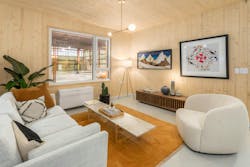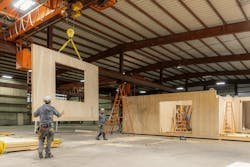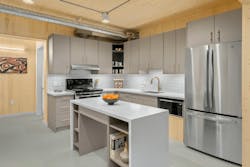Amid a national housing-shortage crisis, few states have it worse than Washington. The State of Washington’s housing gap ranks as the fifth largest in the country, with a deficit of 140,000 housing units, according to a 2022 report by Up for Growth.
Forterra, a Seattle-based land-conservation nonprofit, wants to help change that. Forterra’s Forest to Home initiative aims to reimagine the affordable housing supply chain—by combining responsibly harvested mass timber with modular construction.
AFFORDABLE HOUSING WITH MASS TIMBER
A 2022 finalist for the Ivory Prize, which recognizes affordable-housing solutions, Forest to Home proposes an ecosystem of sustainable, working forest lands; rural towns that produce mass timber; and cities that use the engineered wood to create efficient, affordable housing. Forest to Home also involves a limited equity coop financing structure—which would alleviate the initial financial burden for homebuyers while keeping the homes affordable for future homeowners, says Michelle Connor, president and CEO, Forterra.
Connor describes Forest to Home’s vision this way: “It ties together our commitment to the conservation of working forest land and our desire to help Washington state capture the carbon value of the wood basket that’s unique to the Northwest to produce a high-value engineered wood product that can increase the efficiency of construction,” she says.
As a proof of concept, Forterra has produced a prototype unit using cross-laminated (CLT) wood, replacing traditional carbon-intensive building practices and materials while also lowering the cost of construction. One innovation demonstrated by the two-bedroom, one-bath prototype, Connor says, is its single utility wall. As modular units stack into place, the utility walls would line up vertically and the utilities would be easily and efficiently connected, floor to floor—reducing the amount of onsite labor.
An important part of Forterra’s mission as a nonprofit, Connor adds, involves sharing everything the organization has learned from its Forest to Home prototype with any builder or developer interested in modular affordable housing.
WHAT IS CROSS-LAMINATED TIMBER?
CLT has been touted as an environmentally sustainable construction material that rivals the load-bearing capacity of concrete and steel. While CLT has been used in Europe for decades, U.S. interest in the material has been growing in recent years, with the CLT market forecasted to triple by the end of the decade.
As interest in CLT and sustainable forestry grew, Forterra led a statewide coalition to help make Washington the first U.S. state to allow construction of CLT buildings up to 18 stories, which the state approved in 2018. Through that work, Forterra learned that Darrington, Wash., a once-thriving timber town, had “a keen desire to have a CLT manufacturing facility in their community,” Connor says.
Now, with Forterra’s support and fundraising, Darrington plans to build the Darrington Wood Innovation Center, a 94-acre campus that will manufacture both CLT for modular homes and modular units using CLT panels.
For Connor, what’s most important isn’t building developments that check off all the boxes of its Forest to Home vision: CLT, modularity, and nontraditional financing. Rather, it’s helping to get housing built, even if that means combining some of the Forest to Home elements with traditional housing materials and methods.
“It might take time to get the vision fully realized, but we’ll take as a win every step we take toward that vision,” Connor says. “Getting other people excited to do this on projects across the country is our real motivator.”


